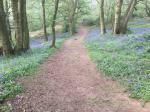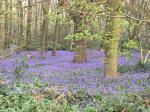Brayton Barff Through the Seasons.
Set in the Vale of York, South West of the market town of Selby and between the villages of Thorpe Willoughby and Brayton, lies Brayton Barff, a sandstone Hill approximately one hundred and fifty feet in height which was formed by glacial movement during the last Ice Age. It is a significant landmark in an otherwise flat landscape.
Today the site is primarily owned by Yorkshire Water with Selby District Council owning a small patch of the land adjacent to the A63 Selby bypass. A large underground reservoir occupies the centre of the site which delivers water to around 4.7 million customers throughout Yorkshire.
Within the Barff woodland over 40% of the trees are Sessile Oak which are generally found in semi natural woodlands in the north of the country. These trees are so called because its acorns are not held on stalks, like those of the English Oak (Pedunculate), but attached directly to the outer twigs. There are also several English Oak trees as well as some cross-hybrid oaks. These trees are known to support many species of flora and fauna, invertebrates, mosses, lichen and fungi.
During the Victorian times it is thought that the shipbuilders on the east coast would come over to the Barff for selected cuts of timber to build their sea going vessels.
The Barff also has a variety of other trees including Silver Birch, Beech, Sycamore, Holly, Rowan, Scots Pine, Alder, Hawthorne and European Larch. There are also several Yew, Willow, Hazel, Horse Chestnut and Wych Elm. As with similar woodlands there are a variety of bushes, including Honeysuckle, Elderberry, Gorse, Broom and Buddleia.
The history of Brayton Barff is quite vague, apparently during 1803 a beacon was lit on the Barff when the country was threatened with an invasion by Napoleon. In May 1935, to celebrate King George V's Silver Jubilee, a Bonfire was lit on the Barff as part of the celebrations.
Early issues of Ordnance Survey Maps dated 1903 clearly show a rifle range on the Barff, extending out to Mill Lane. During the 
Between 2001 – 2004 the A63 Selby bypass, 10km twin lane single carriageway was constructed which severed the South West corner of the Barff, adjacent to Selby Golf Course and resulted in a slight redesign of several holes on the golf course. Wooden fencing was erected as a result of this new road running alongside of the Barff and a footbridge constructed over the ‘new road’ following the line of the Bridal way which extends from Mill Lane. Around 2005/2006 a definite 2metre wide limestone aggregate footpath was laid forming a circular path around the outer edges of the woodland. This footpath is approximately 1.2 miles in length and takes about 30 minutes to circumnavigate at a leisurely pace.
In 2012 the Barff was declared an Ancient Oak Woodland and as such throughout 2012 and 2013 significant work had been carried out by the relevant agencies to cut and remove large swathes of non-native trees, creating at that time huge scars on the landscape. Some three years later the planting of the native trees have become well established and are flourishing. Ongoing maintenance work on the footpath around the bottom of the Barff was completed during the Summer of 2016.
A second phase of woodland maintenance commenced during the Autumn of 2019 with the removal of many old and diseased trees and the cutting back of the Gorse and Broom bushes, especially adjacent to the ‘bypass trail’, this work continued through till March 2020 with re planting continuing into April 2020.
Brayton Barff is a popular site for walkers and bird watchers alike and a path circling the outer perimeter of the Barff makes a pleasant thirty minute walk, giving views looking over towards Selby and the village of Brayton as well as the power stations of Drax and Eggborough..jpg)
For the early risers it is a great place to see some stunning sunrises over the villages of Brayton looking towards Drax Power Station, the same with the Sunsets looking over towards Eggborough and Monk Fryston.
The Barff changes with the Seasons and every visit can reveal something new, the woodland is a haven for wildlife. Records show that since 1982 one hundred and twelve species of bird have been seen in the woodland and at least 40 of those have bred here, including Tawny Owl, Buzzard, Green Woodpecker, Spotted Flycatcher, Goldcrest and Nuthatch to name just a few. On average over 70 species of bird are recorded each year. Further details of the bird life on the Barff can be found on the Brayton Barff Group Facebook page, especially the posts from Derek Cooper. Today ‘The Friends of Brayton Barff group’ led by Derek and a small team of volunteers help keep and maintain the cleanliness of the site as well as recording the wildlife and bird sightings.
The Barff is also home to fifteen different species of mammals, including Muntjac Deer, Pipistrelle Bat, Fox, and Field Vole.
Over eighty species of plant and wildflowers have been recorded, included Bee Orchid, Northern Marsh Orchid, Wood Anemone, Marsh Ragwort, Bluebell, White Bluebell, Bittersweet and Purple and White Foxgloves. Over twenty species of Butterfly have been recorded, including Marbled White, Brown Angus, Speckled Wood, Comma and Brimstone.
During the Autumnal months fungi thrives in this woodland environment, species including Fly Agaric, Beefsteak Tree Fungi, Chicken of the Wood, Sulphur Tufts, Stinkhorn, Ink cap, Puffballs and Hoof Bracket are just some of the many varieties that can be found here.
Click on the galleries shown below to expand the albums.
Sunday 14th April 2019
I have had some cold early starts this last weekend, -1C on Friday and Saturday and -2C this morning. With the cold mornings we have seen some lovely sunrises too, the views from the Barff looking eastward towards Brayton church and Drax power station have been quite spectacular.
The Bluebells are flowering in earnest at the moment, covering a vast area of the eastern side of the Barff as well as smaller pockets around the rest of the woodland. They should, depending on the weather conditions, stay in flower into the second week of May, by which time the ferns and nettles will have smothered them.
I watched the Buzzard for a few minutes this morning, circling and gliding in the morning thermals high above Tap hill, that was until a pair of Crows decided to harass it, eventually it headed off over towards the golf course. It is nice to hear the Willow Warblers and the Blackcaps I could stand and listen to their song for minutes on end. Every now and then the distinctive call of the chiffchaff breaks out from the undergrowth. I heard the call of the Long Tailed Tits towards the end of our walk this morning but haven’t yet managed to see them, there is still plenty of time though. The early morning dawn chorus is quite special at the moment and well worth getting up that little bit earlier.
I still haven’t seen any white bluebells yet, I have seen several facebook posts to say that they are out and about but for the time being I’m afraid I will have to keep looking.
I was fascinated to read the other day that bluebells were voted the country’s favorite flower back in 2015. Apparently they are known by a variety of names, the English bluebell, Wood bell, Bell bottle, Cuckoo’s Boots, Wood Hyacinth, Lady’s Nightcap and Witches Thimble to name just a few. Another interesting fact I read was that half of the world’s bluebells are found in this country. It can take between five to seven years for bluebells to establish from seed to flower and more worrying, especially for the Barff is that it can take several years to recover after being trampled on. If the leaves are crushed they die back from a lack of food as the leaves cannot photosynthesis.
Another important fact worth noting is that the bluebells are protected by law. In this country the British Bluebell is a protected species under the Wildlife and Countryside Act 1981. It is a criminal offence to uproot the wild common bluebell from land on which it naturally grows. Any trade in wild common bluebell bulbs or seeds is also an offence, carrying fines of up to £5,000 per bulb.
I have been listening out recently for the call of the Green woodpecker alas to no avail. I usually hear it calling and laughing around the area of the old farm shop, let’s hope it returns in the next few weeks. Another bird I haven’t heard yet this year is the Cuckoo. I have heard both the Cuckoo and Green Woodpecker over on the reserve at Fairburn Ings but still no signs or sightings yet of them on the Barff.
|



